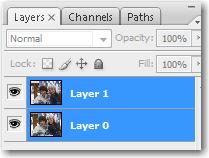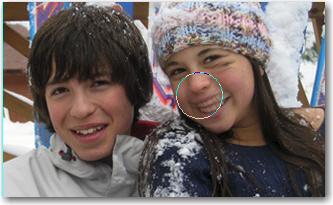Need training at your office? Request a quote for custom training.
Adobe Photoshop: Combining Two Photos for a Perfect Image
By Barb Binder
Updated Apr 17, 2016
Have you ever taken a rapid series of group shots, but can’t find a single image where every single person is looking at the camera, eyes open and smiling? If you are looking for a quick way to combine two mediocre images into one good image, try the Auto-Align Layers in Adobe Photoshop CS3 and later.
Take a look at the two images below. The one on top is better of the boy, but the girl has her eyes closed. In the second picture she looks better, but he’s got one eye closed. There are many ways to combine these two pictures using Photoshop, but the single most efficient technique is to combine both images into one file, each on their own layer. Then, using the Auto-Align Layers command you can let Photoshop line up both images with each other, and then just use a mask to punch through to the underlying image.


Let’s give it a try…
- Open Adobe Photoshop CS3 or later.
- Open the two images you would like to combine.
- Using the Move tool, drag one image into the other file.
- Double-click each layer name in the Layers panel to give each layer a unique name.
- Drag the thumbnails up or down, so that the top layer is the better image, but the bottom layer has a better expression on one or more of the subjects.
Select both layers by clicking on one and then shift-clicking the other.

- Choose Edit > Auto-Align Layers, and set Projection to Auto. (This allows Photoshop to align two rapid sequence photos, making it easy to remove the goofy expressions from the top layer and expose the better expression from the bottom layer). Click on OK.
- While novice Photoshop users may opt to use the Eraser tool to carefully erase the girl’s face from the top layer, for the Intermediate to Advanced user, a Layer Mask is a much better solution. To use a Layer Mask, select the top layer, and choose Layer > Layer Mask > Reveal All.

- Press the letter D on the keyboard to reset your colors to Black and White.

- Use the Brush tool with a soft brush to paint away to the underlying layer, exposing the image underneath. Remember that you can easily decrease/increase the brush size by tapping the [ and ] keys on your keyboard.

- If you remove too much of the top layer, just press the letter X on the keyboard to switch your colors so that White is on top, and paint back in pixels from the top layer.
- When you are done, you’ll have created a much-improved composite image out of two mediocre ones.






Thank you so much for this post, it helped out a lot!!
TNX FOR THIS VERY CLEAR LECTURE..MWH
Thank you so much….
This article helps me alot
Thanks! This helps a lot!
very good post 🙂
Thanks very useful!
im saying thank you because everyone else did
jason apreciates u
I only have Adobe PHOTOSHOP 6 (maybe 7) .. Suppose it is not possible to merge 2 images
on either of these. I am not brilliant on these sites but can cope with normal Photoshop.
Diana: Masking was definitely a feature in the Layers panel in both Photoshop 6 and Photoshop 7.
~Barb
Great instructions! I had the exact issue this image described and like magic with your instructions I was able to correct it to make one perfect image. Thank you so much.
I’m in step 9 and when I start painting with the brush, it is painting in black colors. I think it should reveal the underline layer details instead. What am I doing wrong? Thanks!
Never mind, I found it – I had to select the layer mask before painting with the brushes.
Thanks!
Great thanks… I remember the procedure from PS CIB but couldn’t remember the steps… Was about to spend $43 on a copy … then found your site.